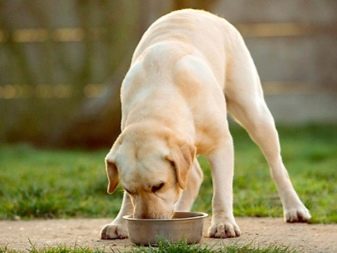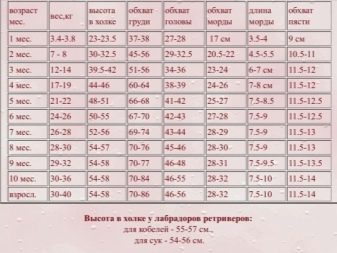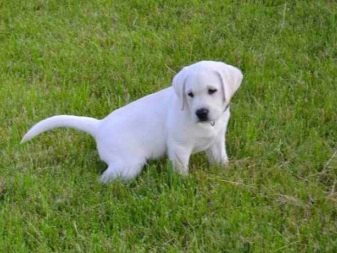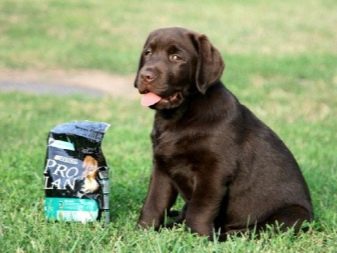Your dream came true, and you took the long-awaited Labrador puppy. Each owner is interested in how his baby grows, does he develop correctly? This breed has its own indicators. Focusing on them, you can evaluate the development of the puppy, whether he has the right nutrition.


Development features
Briefly about the breed itself. Labrador is a medium-sized dog with a balanced psyche, a true friend and companion for the whole family. He loves children very much. True, the guard from him is nowhere. He is always glad to guests in your house. The breed was bred in the XIX century. There are several versions why it was called that. The first is by the name of the Labrador Peninsula. The second is in honor of a black rock called labradorite. The third - the dogs are very hardy and hardworking, and from Portuguese “labrador” is translated as “hard worker”.


There are three stages in development. All of them pass during the first year of the dog’s life. The first lasts about four months and is characterized by rapid growth. At this stage, the puppy gains weight every day. The second, from five to eight months, implies a slower development. In the third stage, which lasts from eight months to a year, a very insignificant increase occurs.
After passing through these stages, the dog can be shown at exhibitions.

Puppy weight and height by age
- In the first month a little kitten is born quite a baby and weighs about 400 grams. Every day he gains an average of 100 grams, and in a week his weight changes by 1 kilogram. It weighs 3-4 kg per month.
- In the second month the pet grows very quickly and reaches a weight of 7-8 kg in 2 months.
- For the third monthGrowing up to 100 grams per day, the pet weighs 12-14 kg by the end of the first trimester.
- Four month old labrador puppy - already quite well-fed baby with a weight of 17-19 kg.Its growth approaches 46 cm at the withers.
- Reaching five months, the puppy is not growing in size so quickly. Parameters range from 21 to 22 kg with an increase of 48-51 cm.
- Six month labrador - It’s not the stuffed bun that you brought into the house, but already looks like an adult dog. With a weight of 24-26 kg, his height is 50-55 cm.
- At 7 months - This is a sexually mature teenager. However, mating should be avoided, as not very pleasant consequences for the dog are possible. Weight from 27 to 28 kg, height 52-56 cm.
- Reaching 8 months of ageLabrador becomes a fully grown animal. Gaining weight is not so much. Fluctuates from 28 to 30 kg and a height of 54-57 cm.
- At 9 months the dog begins to get stronger. Growth is not fundamentally changing. The norm is considered to be weight 29-32 kg, height 54-58 cm.
- At 10 months indicators of an adult dog are present. Weight should be from 30 to 40 kg. Growth at the withers to 58 centimeters. Despite its full size, the Labrador is still a young dog that requires proper care.


The maximum weight of a labrador-boy is 60 kg, girls - 58 kg. Normal weight is 56 and 54 kg respectively.
Based on the indicators presented above, one must not forget that the boy and girl differ in weight and height at the same age. The male is larger and more massive than the female.


Weight and Nutrition Tips
Breeders are advised to conduct system measurements and enter in the weight gain table for months. The table displays the growth of the puppy. And this is an indicator of the proper development of a young dog. But despite the strict criteria that breeders adhere to, one should not forget that the data shown in the table are approximate, since indicators are affected by nutrition and lifestyle. The height and weight of the dog also depends on heredity.
It is necessary to draw on the size of the puppy's parents. The Labrador reaches its full size by one and a half years. It is necessary to ensure that he does not overeat and that he does not have excess fat. This breed is famous for its wild appetite.
Do not forget about regular physical activity. They help develop muscle and bone for your pet.


The weight and height of the labrador depends on the quality of food. Try to buy only high-quality feed. Chappie and Pedigree feeds do not always have a good effect on dog health. Breeders are developing special premium feeds. Buying them in large volumes, you will save a lot of money. The dog is not a person, she does not need a varied diet. The main thing is the balance of fats, proteins and carbohydrates, and, of course, vitamins and minerals.
A veterinarian can recommend a good brand of feed to you. Performing and listening to the recommendations, you will grow a healthy dog with a beautiful constitution, weight, height and shiny coat. It remains to wish good luck in such a pleasant and, at times, difficult matter, as the cultivation and education of a Labrador.
For breed standards, see the next video.








































